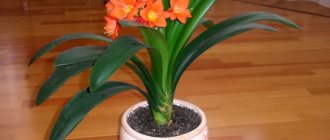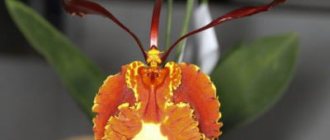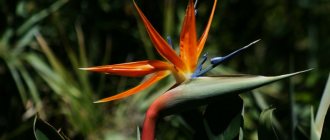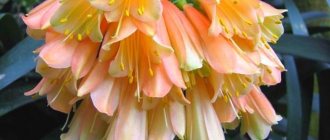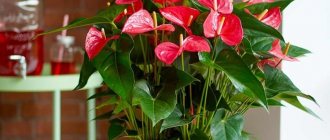Amazonian Eucharis (Eucharis amazonica)
Eucharis, or Amazon lily, is a wonderful indoor bulbous plant. It is not too demanding on lighting; it will grow well near windows, on a table or on a closet shelf. He is happy with normal room temperature all year round. This forest tropical plant does well in the winter garden under the cover of larger plants. It has expressive, large, glossy foliage on long petioles that combines well with many plants. But, of course, the main advantage of eucharis is its beautiful flowering. An umbrella of several white fragrant graceful flowers is formed on a high peduncle. The presence of a yellowish-green crown formed by overgrown stamen filaments makes the flowers look like daffodils. Moreover, with proper maintenance, eucharis blooms 2-3 times a year, if you give it a short period of rest.
Eucharis requires rare transplants and is easy to care for. It reproduces well on its own, forming baby bulbs.
About cultivated species - on the Eucharis page.
|
|
Soil . Eucharis loves rich, moisture-absorbing soil. The optimal soil composition for eucharis is turf soil: leaf soil: sand (2:4:1). Of the ready-made soil mixtures available on the market, soil for flowering plants containing perlite is suitable. But it’s good to add a little loam to it to increase moisture capacity. . Soil acidity – from neutral to slightly alkaline (pH 6.0-7.8). It is best to choose high pots so that a thick layer of drainage can be poured onto the bottom.
Transplant . Eucharis does not tolerate replanting well, so it is done occasionally, every 3-4 years, as the pot becomes full of bulbs. The optimal time for transplantation is after winter flowering, in March. The bulbs are separated carefully, trying not to damage the roots; if necessary, tangled roots can be washed to facilitate the separation procedure. The children are separated and planted separately to grow up.
- Soils and soil mixtures for indoor plants
- Repotting indoor plants
Plant 3-5 bulbs per pot, depending on its diameter, like this. so that the necks of the bulbs are above the ground. The bulbs should not sit too sparsely, because... Close planting and a narrow pot promote flowering. A single bulb in a pot will not produce flower stalks for a long time until the daughter bulbs grow. Leaves are saved when transplanted. At first, water carefully, allowing the top layer of soil to dry. The leaves must be sprayed. The growth of new leaves begins after 1-1.5 months. In the first year after transplantation, eucharis does not bloom.
Lighting . Eucharis naturally grows in tropical forests, so it grows well in shaded areas, but does not tolerate direct sunlight, from which it requires shading. It is best to place it on windows facing west and east, or next to south windows (but not on the windowsill). The plant tolerates the conditions of a bathroom with a window well, where high humidity will be an additional factor for its successful cultivation.
In the summer, the plant can be taken out into the garden, but the place should be shaded, without midday sun rays. It is important to spray the plant to maintain air humidity.
Temperature . This heat-loving tropical plant requires temperatures ranging from +18... +23°C all year round. It should not be exposed to cold drafts. Temperatures within +7... +10°C are critical for the plant, causing the death of leaves and rotting of the bulbs. At the same time, growth stops.
|
|
Watering. The soil must be kept constantly moist, without drying out. At the same time, water moderately, avoiding waterlogging, which leads to rotting of the roots and bulbs. Between waterings, the soil in the pot should dry out by about a third. Water until water comes out into the pan, drain off the excess.
For more details, see the article Rules for watering indoor plants.
Air humidity . Eucharis does not need too high air humidity and can do without spraying. If the atmosphere is too dry, eucharis is sprayed with soft, settled water to increase air humidity. During the flowering period, you can spray less frequently without getting it on the flowers - water causes brown spots to appear on the flowers. The leaves are periodically wiped from dust and a shower is arranged without wetting the soil in the pot.
Feeding . Eucharis must be intensively fed every 2 weeks with complex organic-mineral fertilizer for flowering indoor plants. After flowering, feeding is canceled for the dormant period.
Read more in the article Feeding indoor plants.
Rest period . Eucharis does not require a mandatory rest period. But if you give the plant a relatively dry period of 1-1.5 months, then it can bloom three times a year - in winter, spring and autumn. To do this, after spring flowering, limit watering of the plant, waiting until half the thickness of the soil in the pot dries between waterings. That is, the soil is kept semi-dry. Water moderately, evenly, without wetting the soil too much. At the same time, they provide the plant with good lighting. They don't feed. At the same time, the leaves wither. Possible loss of some leaves.
It has also been established that a similar effect on the induction of flowering has a decrease in the temperature from +26 to +21°C for 3-5 weeks.
Bloom . The main flowering of Eucharis is winter. Repeat flowering is possible at the end of August and in winter. The timing may shift slightly, depending on the conditions of detention and on when you give the plant a rest period.
Eucharis flowers are fragrant, suitable for a bouquet. Cut flowers last about 8 days if the water is changed regularly.
Pests . Eucharis can be affected by aphids and spider mites. When roots and bulbs rot as a result of waterlogging of the soil, fungus gnats appear.
Read more in the article Pests of indoor plants and measures to combat them.
Toxicity . All parts of the plant are poisonous if ingested.
Brief description of the flower
Eucharis is native to South America, more precisely from the Colombian Andes. In the 19th century, the cultivation of this plant began in Europe, where it received the nickname “Amazon lily.” The botanical name has Greek roots and is translated as “full of grace.” The magnificent flowers of this indoor plant, exuding a delicate aroma, fully justify it: the snow-white 12-centimeter petals of the perianth are crowned with a crown of stamens.
The number of corollas on a peduncle varies from 2 to 6, and each of them gracefully hangs down thanks to a long tube. Arrows grow up to 60 cm in height. The leaves are no less decorative: wide, ellipsoidal, sitting on long petioles, dark green and shiny. Protruding longitudinal veins give them a relief texture. They do not die off completely even during the dormant period. The bulbs are spherical, medium-sized.
Problems when growing Amazon lilies
Flower growers often complain that their pet’s leaves wither and then fall off. Constant replacement of foliage is a natural process for the plant. But if the greens wither en masse, there are several reasons for this:
- excessive or insufficient watering;
- too cold or dry air in the room;
- defeat by diseases.
One of the common diseases of eucharis leading to loss of foliage is red burn. The disease is manifested by the appearance of red spots on the leaves and bulbs. Affected onions are thrown out, and healthy ones are treated with fungicides containing copper. The soil is replaced with fresh one.
When will it bloom after planting?
As a rule, the Amazon lily blooms twice a year - in spring and in September. Transplantation by transferring the plant to another pot does not affect the frequency of flowering, subject to the general rules for growing eucharis.
Eucharis is in no hurry to bloom if:
- receives fertilizers and regular watering during the dormant period (in this case, the flower grows leaves, but does not bloom);
- the pot is too spacious (eucharis will strive to fill the space, growing the baby).
To encourage Eucharis, living in comfortable conditions, to flower, a stressful situation is arranged for it: watering is reduced, the temperature is lowered for a couple of weeks, simulating a dormant period. As a rule, after watering is resumed and temperatures rise, the Amazon lily produces a peduncle.
Common types of indoor flowers
The indoor eucharis flower has several types, which differ in size and flowering time.
- Eucharis grandiflora is most often found on window sills. With good care, it is able to bloom three times a year: in late summer, winter and late spring.
- White Eucharis (Eucharis candida) has wider elliptical leaves, pointed at the tips. Their length can reach 40 cm and width - 15 cm. Peduncles with a brownish-green tint appear in early spring.
- Eucharis mastersii is more compact in size: the length of its leaves does not exceed 25 cm. It forms no more than two inflorescences on each arrow.
- Another compact species, Eucharis sanderi, has heart-shaped leaf bases. It blooms between February and April.
- Eucharis subedentata or, as it is sometimes called, callifruria toothless, is distinguished by its abundant flowering - 6-8 inflorescences per arrow. It is easily recognized by its oblong leaves of an unusual “triangular” shape, sitting on long grooved petioles.
Home care
The Amazon lily is a completely unpretentious indoor plant that can survive even with violations of agricultural practices. When purchasing it, you only need to take care to allocate a sufficiently spacious place for a spreading bush. If you care for eucharis at home correctly, the plant will be able to bloom several times a year. To achieve full “return” from it, it is enough to follow a few basic rules.
Lighting
Eucharis “likes” bright, diffused light. It easily tolerates partial shade, but for regular planting of buds, windows facing west and east are more suitable. On loggias and outdoors, where the plant can be moved in the warm season, it is protected from directed sunlight.
Temperature
The plant is relatively thermophilic. Eucharis feels comfortable at an air temperature of at least 18 degrees. At 10 degrees, the leaves and bulbs begin to freeze. He also does not like changes - the greater the difference between day and night temperatures, the smaller the flowers. It is important to remember this feature when keeping Amazon lilies outdoors or on the balcony. In early spring or August, when the nights are quite cold, it is protected with a greenhouse or brought into a warm room.
Air humidity
Like any native of the tropics, eucharis requires high humidity at home. It benefits from year-round spraying with soft water. Periodically wipe the leaves with a damp sponge to remove dust. You can place it on a tray with wet expanded clay - this method is especially good during the heating season, when the plant suffers most from dry air.
Watering
The amount of water consumed by Eucharis depends on the time of year. During the period of active growth, the substrate is kept moderately moist. That is, the earthen lump should be wet, but without stagnation of water. Its excess from the pallets must be drained. Water approximately every 3-4 days, generously. In winter, during semi-dormancy, the top layer of soil is allowed to dry out without allowing the lump to completely dry out.
It is important that the pot does not overcool - the bulb rots in wet and cold soil. Moreover, the process begins from the bottom, which means that the problem becomes noticeable only when it is too late to save it.
Fertilizer application
The plant is fed twice a month, except for the dormant period. It is better to use fertilizers for flowering indoor plants with a predominance of phosphorus and potassium. For full growth, eucharis needs not only mineral, but also organic supplements, so it is better to alternate them. After flowering ends, feeding is stopped, allowing the Amazon lily to enter the “resting” stage.
Care after purchase
Unlike most bulbous plants, eucharis painfully tolerates the complete loss of leaves. However, planting material can only be purchased in a state of deep dormancy and complete leaflessness. Such an onion must be immediately “rescued”: placed in the ground so that the top remains uncovered, placed in a bright and, most importantly, warm place. Can be pre-treated with fungicides and stimulants (Epin or Zircon). Water carefully - during this period the plant is susceptible to rotting. Young leaves should appear soon.
If you purchased a plant that is already flowering, water and fertilize it as usual until the end of flowering. Afterwards, if you want to preserve eucharis at home for a long time, you will need to transplant it into a larger container, completely replacing the soil. The reason for such “extraordinary” measures is that in large greenhouses, flowers are grown using drip irrigation, which means they “sit” in peat or coconut fiber. This substrate is not suitable for growing on home windowsills - it does not contain the necessary nutrients.
Care during and after flowering
When eucharis begins to bloom, you should stop spraying - excess moisture negatively affects the appearance of the umbrellas. Feeding continues.
At the end of flowering, watering is reduced, fertilizers are stopped - the eucharis goes “to rest”. During this period, it is important to prevent both the complete death of adult leaves and the appearance of young ones. This is achieved by manipulating the moisture content of the earthen clod. If it is high, the bulb will begin to grow without resting, which will negatively affect future flowering. If it is too low, the plant will begin to “defend itself” by dropping leaves. Eucharis endures their complete loss extremely painfully, even to the point of death.
An adult healthy bulb needs 4-6 weeks to rest. After the specified period, the plant is “awakened” by increasing watering and fertilizing. By correctly alternating periods of rest and active growth, you can achieve twice, and sometimes three times, flowering.
We recommend reading
How to care for an Amaryllis flower
Home care for Anthurium flowers
Features of caring for Azalea at home
Home care for Cyclamen
Plant after flowering
Unfortunately, eucharis flowering does not last as long as many would like. Immediately after its completion, you need to carry out a number of procedures:
- Wait until the flower stalk is completely dry.
- During the waiting period and in the period after it, you cannot add any fertilizers; you need to water the flower as rarely as possible, without allowing the soil to dry out too much (add water only when the substrate has dried by 2/3 of its volume).
- Reduce the air temperature in the room to +16...+17 degrees. But lower the indicators carefully, since the Amazon lily is still a heat-loving plant and will not tolerate sudden changes.
- If the plant has formed young leaves, then increase the amount of watering and resume fertilizing. This will help speed up metabolic processes and give the plant energy to form fresh buds.
Important! If eucharis has resumed active growth, this means that it is completely ready for a new flowering period.
Reproduction of Eucharis
The Amazon lily can be propagated by seeds or daughter bulbs. As for the first method, it is used only in professional floriculture. Eucharis “daughters” are propagated in March, separating them during transplantation so that several bulbs remain in each “bundle.” This way, during separation, the roots are less injured, and young plants take root faster. For better rooting, use bottom heating. They develop quickly and can bloom as early as next year.
There is no need to separate the young each year unless you want to quickly propagate Eucharis. The presence of children contributes to abundant and more frequent flowering of the mother bulb.
Transfer
Eucharis does not require annual transplants. For an adult plant, it is enough to increase the volume of the pot every 3-4 years. If necessary (to separate the children), you can change the soil annually, leaving the plant in the same container.
Choosing a pot and suitable soil
Eucharis is a large and tall plant, so it is better to choose a ceramic pot for it. Unlike most indoor plants, the Amazon lily grows better in spacious containers - after all, the abundance and frequency of flowering is directly related to the number of daughter bulbs. Usually they quickly fill all available space, creating spectacular “thickets” around the flowering plant.
The soil for eucharis should have good moisture holding capacity and contain leafy soil, sand and loam (4:2:1). To improve the mechanical properties and prevent moisture stagnation, add 1 part of a baking powder to the soil: peat or coconut fiber.
Step-by-step transplant process
If the bulb is healthy and has leaves, planting eucharis is done as follows:
- The plant, along with the earthen lump, is carefully removed from the pot.
- The earth “not grabbed” by the roots is shaken off.
- If necessary, the “daughters” are separated, trying to disturb the root system of the mother bulb as little as possible.
- A layer of expanded clay and some fresh soil are poured into a new container.
- The lump is placed in a new pot and the substrate is added. If there are leaves, a depth of up to 5 cm is allowed.
Such a transplant at home does not harm the eucharis, and soon it begins to produce young leaves and, possibly, flower stalks.
How to make the buds bloom?
If your Amazon lily does not want to bloom, then you can cheat a little and stimulate the formation of flower stalks. To do this, you need to force the flower into a dormant state:
- reduce watering;
- move the flowerpot with the plant to a less bright place;
- Reduce the temperature in the room.
This will help artificially create conditions for the plant to enter the resting phase at an unusual time.
Important! You shouldn't do this kind of stimulation too often. This can lead to the weakened plant never blooming again.
The video talks about how to stimulate eucharis flowering:
Diseases and pests
Eucharis is resistant to most pests. When kept outdoors in summer, it can be affected by aphids. In rare cases, a plant may be “attacked” by a spider or root mite. In the first case, use any systemic insecticides, for example, Aktara, Konfidor. In the second, acaricides such as Neoron, Kleschevit or Fitoverm will help get rid of parasites.
The roots of weakened or rotting bulbs can be gnawed by fungus gnat larvae. They appear only when agricultural practices are violated and do not harm healthy plants. In this case, it is important to concentrate not on getting rid of insects, but on preventing further decay.
The most dangerous of the fungal diseases that can affect eucharis is fusarium or red rot. If it appears, the bulb is removed from the soil, the rotten parts are cut off and kept in strong fungicides, such as Fundazol or Copper Oxide. But it is easier to prevent this disease by avoiding coolness and excessive dampness.




